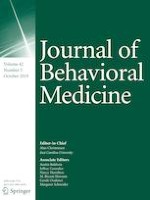27-02-2019 | Brief Report
Reactance to anti-binge drinking messages: testing cognitive and affective mechanisms among noncollege emerging adults
Gepubliceerd in: Journal of Behavioral Medicine | Uitgave 5/2019
Log in om toegang te krijgenAbstract
Strong health messages may result in reactance, increasing unhealthy behaviors. Reactance is purported to be derived of both cognitive and affective factors. The current study investigated the extent to which these cognitive and affective reactance components accounted for the link between message exposure on intentions and behavior. Emerging adults who never attended college (N = 244) completed an online study assessing anger and negative cognitions towards high or low threat anti-binge drinking messages. Intentions to drink and binge drink in the next week and drinking behaviors 1 week later were assessed. High threat messages elicited more anger and negative cognitions than low threat messages. High threat messages had a significant total indirect effect on intentions but had no effect on drinking behaviors. These outcomes suggest that while immediate cognitive and affect reactance has an effect on intentions, it may not influence longer-term decision making and may not outweigh benefits of strong messages.
